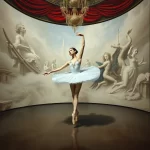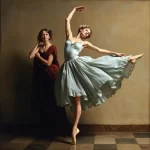Russian Ballet: From Imperial Courts to Global Domination

Introduction
Ballet, a highly technical form of dance with its origins in the Italian Renaissance courts, has evolved into a global art form. Among the many cultures that have embraced and transformed ballet, Russia stands out for its profound and lasting impact. Russian ballet has not only shaped the art form within its borders but has also significantly influenced the global ballet scene. This article explores the journey of Russian ballet from its inception in the imperial courts to its current status as a dominant force in the world of dance.
Origins of Ballet in Russia
Early Influences
Ballet was introduced to Russia in the early 18th century during the reign of Peter the Great, who sought to modernize Russia by adopting Western European cultural practices. The Tsar invited foreign artists, including ballet masters, to the Russian court. The early influences on Russian ballet were primarily French and Italian, as these countries were the leading centers of ballet at the time. Local folk dances and cultural traditions also played a role in shaping the unique character of Russian ballet.
Key Figures
One of the pivotal figures in the establishment of ballet in Russia was Jean-Baptiste Landé, a French ballet master who was invited to St. Petersburg in 1734. Landé founded the first Russian ballet school, which later became the Imperial Ballet School. Another significant figure was Charles Didelot, a French choreographer who arrived in Russia in 1801. Didelot’s innovative techniques and dramatic storytelling greatly influenced the development of Russian ballet.
Development and Evolution
Formative Years
The formative years of Russian ballet were marked by the establishment of key institutions and the development of a distinct style. The Imperial Ballet School, founded by Landé, played a crucial role in training generations of Russian dancers. The Mariinsky Theatre in St. Petersburg and the Bolshoi Theatre in Moscow became the primary venues for ballet performances. During this period, Russian ballet began to incorporate elements of Russian folklore and literature, creating a unique blend of Western techniques and local traditions.
Cultural Integration
Ballet quickly became an integral part of Russian cultural life, enjoying patronage from the imperial court and the aristocracy. It was not just a form of entertainment but also a symbol of cultural sophistication and national pride. The Russian public embraced ballet, and it became a popular art form across different social strata. The political climate also played a role, as the Russian rulers used ballet to project an image of cultural refinement and power.
Signature Style and Techniques
Unique Characteristics
Russian ballet is renowned for its technical precision, emotional depth, and dramatic storytelling. One of its unique characteristics is the emphasis on expressive, lyrical movements that convey a wide range of emotions. Russian ballet also places a strong focus on rigorous training and discipline, producing dancers with exceptional technical skills. The use of grand, elaborate sets and costumes is another hallmark of Russian ballet, adding to its visual and emotional impact.
Influences on Global Ballet
Russian ballet has had a profound influence on the global ballet scene. The works of Russian choreographers like Marius Petipa, who created iconic ballets such as “Swan Lake,” “The Sleeping Beauty,” and “The Nutcracker,” have become staples in ballet repertoires worldwide. The Russian style of ballet, characterized by its technical brilliance and emotional expressiveness, has set a high standard for ballet companies around the world.
Notable Ballet Companies and Schools
Major Ballet Institutions
Russia is home to some of the world’s most prestigious ballet companies and schools. The Mariinsky Ballet (formerly the Kirov Ballet) in St. Petersburg and the Bolshoi Ballet in Moscow are two of the most renowned ballet companies globally. Both institutions have a rich history and have produced some of the greatest dancers and choreographers in the world. The Vaganova Academy of Russian Ballet in St. Petersburg and the Bolshoi Ballet Academy in Moscow are among the top ballet schools, known for their rigorous training programs and high standards.
International Recognition
Russian ballet companies and schools have received numerous awards and accolades, cementing their status as leaders in the ballet world. The Mariinsky and Bolshoi Ballets regularly tour internationally, showcasing their exceptional talent and artistry. Russian dancers and choreographers are highly sought after by ballet companies worldwide, further spreading the influence of Russian ballet.
Iconic Ballet Performances and Choreographies
Signature Ballets
Some of the most famous ballets originated in Russia, including “Swan Lake,” “The Sleeping Beauty,” and “The Nutcracker,” all choreographed by Marius Petipa. These ballets are known for their intricate choreography, beautiful music by composers like Pyotr Ilyich Tchaikovsky, and timeless themes. “Swan Lake,” with its tale of love and betrayal, is particularly iconic and has been performed by ballet companies around the world.
Influential Choreographers
In addition to Marius Petipa, other influential Russian choreographers include Michel Fokine, who introduced modernist elements to ballet, and George Balanchine, who co-founded the New York City Ballet and revolutionized ballet with his neoclassical style. These choreographers have made significant contributions to the art form, pushing the boundaries of ballet and inspiring future generations of dancers and choreographers.
Contemporary Ballet in Russia
Modern Developments
In the contemporary era, Russian ballet continues to evolve, incorporating new styles and techniques while maintaining its classical roots. Modern Russian choreographers like Alexei Ratmansky and Boris Eifman are known for their innovative works that blend classical ballet with contemporary dance. New ballet companies and schools have also emerged, contributing to the vibrant ballet scene in Russia.
Current Challenges and Opportunities
Despite its rich tradition, Russian ballet faces several challenges, including funding issues, political pressures, and the need to attract younger audiences. However, there are also opportunities for growth and innovation. The global popularity of ballet provides a platform for Russian ballet to reach new audiences and continue its legacy. Collaborations with international artists and companies can also bring fresh perspectives and ideas to Russian ballet.
Cultural Impact and Legacy
Cultural Significance
Ballet holds a special place in Russian culture, symbolizing artistic excellence and national pride. It has shaped and been shaped by Russian culture, reflecting the country’s history, values, and artistic sensibilities. Ballet has also played a role in Russia’s cultural diplomacy, showcasing the country’s artistic achievements to the world.
Global Influence
The influence of Russian ballet extends far beyond its borders. Russian dancers, choreographers, and teachers have made significant contributions to ballet companies and schools worldwide. The Russian style of ballet, with its emphasis on technical precision and emotional expressiveness, has set a high standard for ballet globally. Iconic Russian ballets and choreographies continue to be performed and celebrated around the world, ensuring the lasting legacy of Russian ballet.
FAQ
What is the history of ballet in Russia?
Ballet was introduced to Russia in the early 18th century during the reign of Peter the Great. It quickly became an integral part of Russian cultural life, with key institutions like the Imperial Ballet School, the Mariinsky Theatre, and the Bolshoi Theatre playing significant roles in its development. Russian ballet evolved to incorporate elements of Russian folklore and literature, creating a unique blend of Western techniques and local traditions.
Who are the most influential figures in Russian ballet?
Some of the most influential figures in Russian ballet include Jean-Baptiste Landé, Charles Didelot, Marius Petipa, Michel Fokine, and George Balanchine. These pioneers and choreographers have made significant contributions to the development and evolution of Russian ballet.
What makes Russian ballet unique?
Russian ballet is known for its technical precision, emotional depth, and dramatic storytelling. It emphasizes expressive, lyrical movements that convey a wide range of emotions. The use of grand, elaborate sets and costumes is another hallmark of Russian ballet, adding to its visual and emotional impact.
How has Russia influenced global ballet?
Russian ballet has had a profound influence on the global ballet scene. The works of Russian choreographers like Marius Petipa have become staples in ballet repertoires worldwide. The Russian style of ballet, characterized by its technical brilliance and emotional expressiveness, has set a high standard for ballet companies around the world.
Are there any famous ballets from Russia?
Some of the most famous ballets that originated in Russia include “Swan Lake,” “The Sleeping Beauty,” and “The Nutcracker,” all choreographed by Marius Petipa. These ballets are known for their intricate choreography, beautiful music by composers like Pyotr Ilyich Tchaikovsky, and timeless themes.
How can I learn more about ballet in Russia?
To learn more about ballet in Russia, you can explore books such as “Apollo’s Angels: A History of Ballet” by Jennifer Homans and “Bolshoi Confidential: Secrets of the Russian Ballet from the Rule of the Tsars to Today” by Simon Morrison. Documentaries like “Ballets Russes” and “Bolshoi Babylon” also provide valuable insights into the world of Russian ballet.
Conclusion
Summary
Russian ballet has a rich and storied history, from its introduction in the imperial courts to its current status as a global powerhouse in the world of dance. Key figures like Jean-Baptiste Landé, Charles Didelot, and Marius Petipa played pivotal roles in establishing and shaping Russian ballet. The unique characteristics of Russian ballet, including its technical precision and emotional depth, have set a high standard for ballet worldwide. Prestigious institutions like the Mariinsky Ballet and the Bolshoi Ballet continue to uphold the legacy of Russian ballet, while contemporary choreographers and dancers push the boundaries of the art form.
Reflection
The lasting impact of Russian ballet on the global ballet community is undeniable. Its rich tradition, innovative choreographies, and exceptional talent have left an indelible mark on the world of dance. As Russian ballet continues to evolve and adapt to contemporary trends, it remains a symbol of artistic excellence and cultural pride. The legacy of Russian ballet will undoubtedly continue to inspire and influence future generations of dancers and choreographers around the world.



